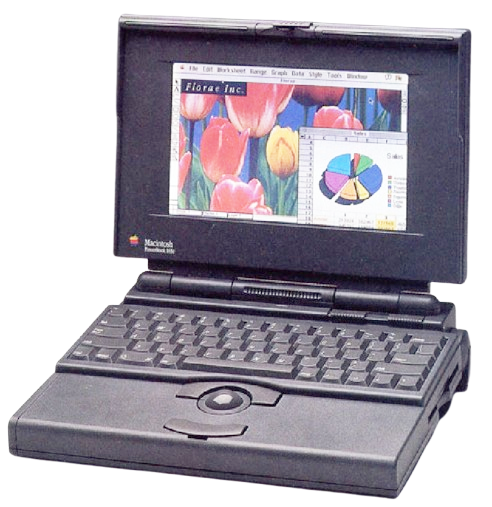
Apple PowerBook 165c
The PowerBook 165c was the first Apple laptop with a color screen.
Specifications
| Spec | Details |
|---|---|
| Release Date | February 1993 |
| Discontinuation Date | December 1993 |
| Processor | Motorola 68030 @33MHz FPU: Yes Bus Speed: 33MHz |
| RAM | PowerBook 165c/180c Proprietary Standard: 4MB Maximum: 14MB |
| Hard Disk | 2.5" SCSI Standard: 80 or 160MB |
| Display | 8.9" Passive Matrix Color LCD @640x400 |
| GPU | Western Digital WD90C26 VRAM: 512KB |
| Main Battery | NiCad |
| PRAM Battery | VL2330 Lithium (Soldered) |
| Power Supply | Barrel Jack - 7.5V 3A - Apple M5652 |
| Disk Drives | 3.5" 1.44MB Floppy Drive |
| PC Cards | None |
| Networking | Optional Modem |
| Other I/O | - 2x Serial - 1x HDI-30 SCSI - 1x Apple Desktop Bus - 1x Mini-15 Video Out - 1x Mic In - 1x Line Out |
| Pointing Device | Trackball |
| Minimum Mac OS | System Software 7.1 |
| Maximum Mac OS | Mac OS 7.6.1 |
Upgrades
SSD Upgrade
See our page on SCSI SSDs for more info.
Resources
 Service Manual |
Capacitor Reference |
|---|
Common Faults & Maintenance
The PowerBook 165, like other 100 series laptops, suffers from many different issues.
Broken Plastic
The plastic parts on the 165c have shrunk very slightly with time. As plastic can't shrink around the brass inserts inside every screw mount, these pretty much all crack and break. Do not confuse this with the brittle plastic disease that affects most laptops from the 1990s - these plastics are otherwise far more solid. The main mounts that break will be the ones for the hinges, and the ones for the drive cage.
Hinge Fixing
Multiple methods can be used to prevent and fix these weak screw mounts. The one I'd recommend the most is to replace the old brittle mounts with new 3D-printed ones. These new mounts include a large plastic plate that mounts behind the LCD, in order to allow extra area for the part to be glued to, and to relieve stress from the mounts themselves. These parts when applied correctly are very strong and last a long time.
Another method of repair if you don't have access to a 3D printer is epoxy. Lots of epoxy. This method works best if the original mounts are still intact, as otherwise they can be very difficult to reassemble. The idea is that you put a bunch of plastics epoxy around all of the mounts, in order to prevent them from breaking, and to add extra rigidity to the area. This can work when done right, but I'd still recommend the 3D printing approach if possible.
LCD Failure
The 165c's LCD uses through hole electrolytic caps that do not leak as badly as the surface mount type used on other models. Still, they can leak and I'd highly recommend replacing them. The larger issue with the 165c LCD is that it seems to be especially prone to developing bad lines and other defects, of which there is no easy fix.
Capacitor Reference info for this model is linked in the resources section.
Hard Drive Failure & Repair
These PowerBooks used SCSI 2.5" drives, which are pretty tough to find nowadays. If you do have a dead drive, I'd recommend replacing it with a modern solid state solution instead of paying silly money for spinning rust off eBay. Multiple options are available, and more info is available here.
Battery Leaks
The main battery for the 100 series PowerBooks is NiCad based, so they leak pretty frequently. Don't leave an intact one in your laptop, and make sure to check any unit you get your hands on for one. Usually the logic board only ends up damage in the event of a pretty severe leak luckily. Also, if the battery has shorted (which is pretty common), the laptop won't start with it installed. If you have a known-good AC Adapter and your PowerBook is acting dead, there's a good chance that's why.
The PRAM battery in the 165c is a rechargeable Lithium coin cell. These rarely leak. Still probably a good idea to remove it if you get the chance though, but be warned, it is soldered right to the internal interconnect board, so getting it out is a bit of a pain.
Power Supply Failure
The original 3-amp power supply for these laptops is prone to leaky capacitors and should be recapped. You can find cap reference for this power supply here.
Page last updated (MM/DD/YYYY): 03/20/2025
Update Reason: image replaced
Back-Navigation
Home < Macintosh Portal < PowerBook < PowerBook 165c